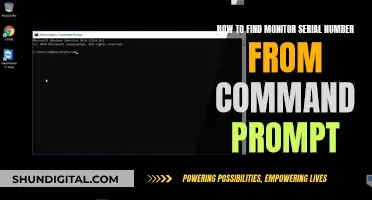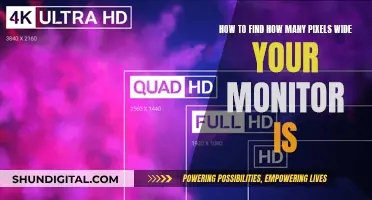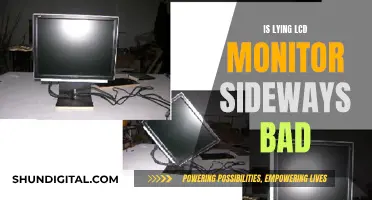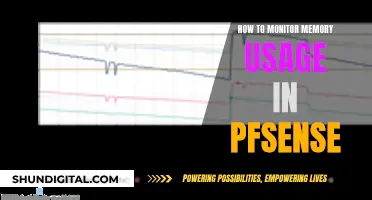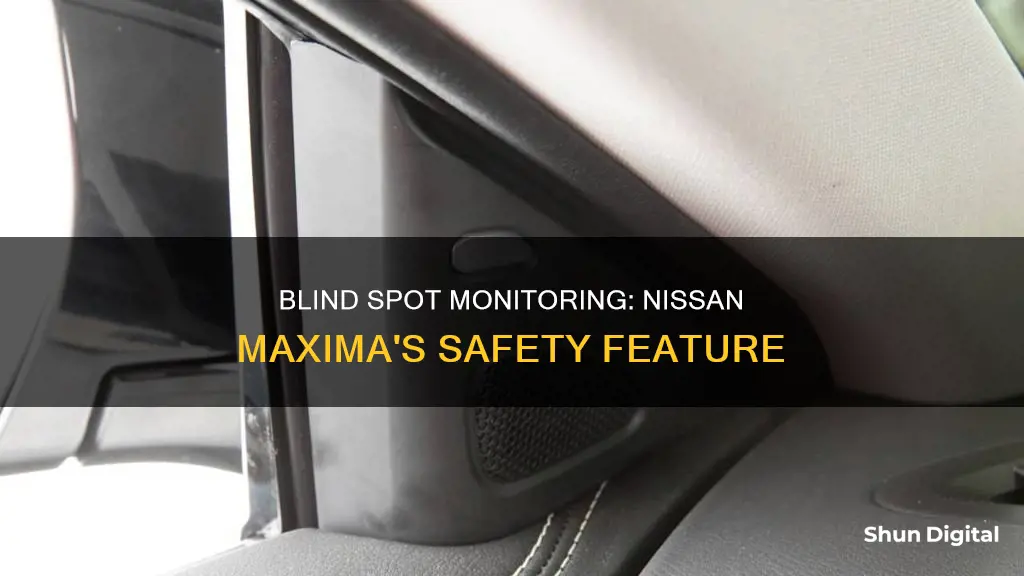
The Nissan Maxima is a car model that offers a range of safety features, including blind-spot monitoring. The blind-spot warning system, also known as BSW, uses radar sensors installed near the rear bumper to detect vehicles in adjacent lanes, alerting the driver to potential hazards when changing lanes. This feature is part of the Nissan Safety Shield package, which also includes forward and reverse automatic emergency braking, rear cross-traffic alert, pedestrian detection, and forward collision warning. The BSW system is designed to enhance the driver's awareness and prevent collisions, but it should not be solely relied upon, and proper driving procedures should always be followed.
| Characteristics | Values |
|---|---|
| Blind Spot Warning | Equipped with radar sensors near the rear bumper to detect vehicles in adjacent lanes |
| RearView Monitor | Uses the rearview monitor camera to detect vehicles behind and to the sides |
| Detection Zone | Extends approximately 10 ft behind and to the sides of the vehicle |
| Indicator Light | Located near the side mirror; flashes red or green |
| Chime | Sounds when the indicator light flashes |
| Activation Speed | The BSW system operates above approximately 20 mph |
| Driver Assistance Settings | Can be turned on or off using buttons on the left side of the steering wheel |
What You'll Learn

Nissan Safety Shield 360
Blind Spot Warning
This feature uses the rearview monitor camera to detect vehicles in the driver's blind spot area, providing both visual and audible alerts to help with lane changes. The system is designed to work alongside the driver's use of mirrors and standard blind spot checks, adding an extra layer of safety. When a vehicle is detected, a chime will sound, and an indicator light will flash—green for all clear, and red if it is unsafe to change lanes.
Lane Departure Warning
This system helps prevent accidental lane drift by alerting the driver with a visual warning and audible or haptic signals if the vehicle is drifting out of its lane. This feature ensures drivers only change lanes intentionally, reducing the risk of sideswiping accidents.
High Beam Assist
High Beam Assist is a helpful feature for night driving. It automatically switches to low beam headlights when it senses oncoming traffic, ensuring that other drivers are not dazzled by your lights. The system will then turn the high beams back on when appropriate.
Rear Cross Traffic Alert
This alert system is designed to assist with reversing out of parking spots by warning the driver of approaching vehicles that may be out of their direct line of sight. This helps to reduce the risk of collisions when backing out of tight or obstructed spaces.
Rear Automatic Braking
Rear Automatic Braking is a system that watches for stationary objects directly behind the vehicle. If the driver fails to stop and a collision is imminent, the system can automatically engage the brakes to avoid or reduce the severity of a rear-end collision.
Automatic Emergency Braking with Pedestrian Detection
This safety feature uses forward-facing radar and camera technology to track vehicles and crossing pedestrians in front of the car. It can provide audible and visual warnings and even apply the brakes to help avoid or mitigate frontal collisions.
Best Places to Buy an OVD Monitor
You may want to see also

How does the BSW system work?
The BSW (Blind Spot Warning) system in the Nissan Maxima is designed to help alert the driver of other vehicles in adjacent lanes when changing lanes. It is part of the Nissan Safety Shield technologies, which also include forward and reverse automatic emergency braking, rear cross-traffic alert, pedestrian detection, and forward collision warning.
The BSW system uses radar sensors installed near the rear bumper to detect vehicles on either side of your car within a specific detection zone. This zone starts from the outside mirror and extends approximately 10 feet (3.0 meters) behind and to the side of the rear bumper. The system operates when the car is travelling at speeds above 20 mph (32 km/h).
When the BSW system is enabled and you signal for a lane change, you will hear a chime and see an indicator light near the side mirror. If the lane is clear, the light will be green; if there is a vehicle in your blind spot, the light will flash red, indicating that you should not change lanes.
It is important to note that while the BSW system is a valuable safety feature, it should not be solely relied upon. Drivers should always use proper driving procedures, including checking side and rear mirrors and turning to look in the direction of the lane change, to ensure it is safe before making any manoeuvres.
Adjusting Extended Monitor Size: A Simple Guide to Downsizing
You may want to see also

Radar sensors and detection zones
Radar sensors are an integral part of modern cars' advanced driver assistance systems (ADAS). They are especially vital for autonomous vehicles and also improve safety and comfort for drivers.
Radar sensors use Frequency Modulated Continuous Wave (FMCW) radar to detect moving or stationary targets, including cars, trains, trucks and cargo in extreme weather conditions. They are ideal for long-range outdoor applications up to 40 meters and can be configured to detect objects up to a specified distance, increasing accuracy. They are also highly flexible in terms of mounting, which makes them safer and easier to install and maintain.
Radar sensors are used for blind spot detection, lane change assistance, collision mitigation, parking aid, and rear cross-traffic alert features. They can be placed on all four corners of the vehicle to detect obstacles or pedestrians before they are visible to the driver and deploy automatic emergency braking.
In the context of the Nissan Maxima, the blind spot warning system is part of the Nissan Safety Shield technologies. This system uses the rearview monitor camera to detect vehicles in the blind spot area, preventing collisions when changing lanes. When enabled, the driver will see an indicator light near the side mirror. If a lane change is signalled, a chime will sound and the light will flash: green means all clear, and red means don't change lanes.
Radar sensors offer excellent detection of both moving and stationary objects from a distance, with higher accuracy than traditional sensors. They are also unaffected by ambient weather conditions such as wind, rain, fog, light, humidity and temperature, making them ideal for outdoor use.
Scaling Monitor Display: Adjusting Size for Optimal Viewing
You may want to see also

BSW system limitations
The BSW system is not a replacement for proper driving procedure and is not designed to prevent contact with vehicles or objects. When driving a Nissan, always use the side and rear mirrors and always turn your head and look in the direction you will move to ensure it is safe to change lanes. Never rely solely on the BSW system.
There is a limitation to the detection capability of the radar. Using the BSW system under some road, lane marker, or weather conditions could lead to improper system operation. Always rely on your own operation to avoid accidents.
The BSW system operates at speeds above approximately 32 km/h (20 MPH).
The BSW system uses radar sensors installed near the rear bumper to detect other vehicles in an adjacent lane.
Finding the Right External Monitor for Your Setup
You may want to see also

Other Nissan models with BSW
The Nissan Maxima does have blind spot monitoring, also known as Blind Spot Warning (BSW) or Blind Spot Intervention (BSI). This feature is part of the Nissan Safety Shield technologies, which also include a rearview monitor camera, lane departure warning, and rear cross-traffic alert. The system uses radar sensors on the rear bumper to detect vehicles in adjacent lanes, alerting the driver with an indicator light and a chime if a vehicle is approaching.
- Altima
- Murano
- Rogue
- Frontier King Cab
- Frontier Crew Cab
- ARIYA
The BSW system can be turned on or off using the Driver Assistance settings, which can be accessed via buttons on the left side of the steering wheel. It is important to remember that while BSW can assist drivers in avoiding collisions, it is not a substitute for proper lane change procedures and drivers should not rely solely on the system.
Monitor Size for Office Workers: What's the Sweet Spot?
You may want to see also
Frequently asked questions
Yes, the Nissan Maxima has blind spot monitoring.
The system uses radar sensors installed near the rear bumper to detect other vehicles in adjacent lanes. The detection zone starts from the outside mirror of your vehicle and extends approximately 10 feet (3.0 m) behind the rear bumper and about 10 feet (3.0 m) sideways.
When the feature is enabled, you will see an indicator light near the side mirror. If you signal for a lane change, a chime will sound and the light will flash: green means all clear, and red means stay put.
Yes, you can access the Driver Assistance settings using the buttons on the left side of your steering wheel. The function is listed as Blind Spot or BSW, and there is a button to turn it on or off.
No, the system is not designed to prevent contact with vehicles or objects. Always use your side and rear mirrors and turn to look in the direction your vehicle will move when changing lanes. Never rely solely on the BSW system.


